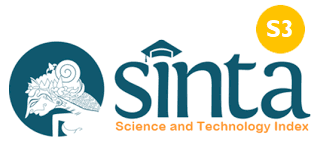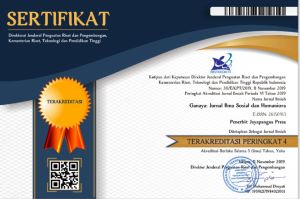Peran Anggota Keluarga Lain dalam Komunikasi Keluarga antara Anak Perempuan dengan Single Father
DOI:
https://doi.org/10.37329/ganaya.v8i1.3662Keywords:
Komunikasi keluarga, Pola komunikasi, Anak perempuan, Ayah tunggal, Anggota keluarga lainAbstract
This study aims to find out the communication patterns formed in family communication between daughters and single fathers with the help of other family members' roles in it. This study uses a narrative study approach with a constructivist paradigm to explore individual experiences and the meanings they build in their communication interactions. The informant in this study is a daughter who no longer has a mother because she died and lives at home with other family members. The results of the study indicate that the communication pattern between daughters and single fathers in this study is protective, where the communication pattern is oriented towards high conformity and low conversation. One of these is the discovery of a communication barrier, where daughters feel unable to freely open up to single fathers without a communication bridge such as other family members in the communication between them so that daughters feel less heard because fathers choose to maintain good relationships so that future conflicts can be avoided. This study also emphasizes the importance of additional supporting data in narrative studies, such as follow-up interviews, to provide a more comprehensive picture of the dynamics of communication in families between daughters and single fathers with the help of other family members' roles. By understanding the factors that influence the formation of this communication pattern, this study is expected to contribute to the development of better communication strategies in families with single parent conditions, especially single fathers, and provide insight for practitioners and researchers in the field of family communication. This study also provides practical significance for intervention efforts and social support for families facing similar challenges.
References
Aisy, N. S., & Purba, V. (2021). Pola Komunikasi Single Parent Terhadap Perkembangan Karakter Anak. Jurnal Common, 4(2), 160-171.
Annuar, K., & Sa’adah, N. (2023). Pentingnya Komunikasi Keluarga Terhadap Perkembangan Remaja Dan Faktor Yang Menyebabkan Kurang Efektifnya Komunikasi Dalam Keluarga. Cons-Iedu, 3(1), 20-26.
Baharuddin, B. (2019). Pengaruh Komunikasi Orang Tua Terhadap Perilaku Anak Pada Min I Lamno Desa Pante Keutapang Aceh Jaya. Jurnal Al-Ijtimaiyyah, 5(1), 105-123.
Creswell, J. W. (2018). Research Design: Qualitative, Quantitative, And Mixed Methods Approaches Fifth Edition. SAGE Publications.
Cruzes, D. S., & Dyba, T. (2011). Recommended Steps for Thematic Synthesis in Software Engineering. 2011 International Symposium on Empirical Software Engineering and Measurement, 275-284. IEEE.
Derlega, V. J., Metts, S., Petronio, S., & Margulis, S. T. (1993). Self-disclosure. US: Publications, Inc.
Duvall, E. R. M., & Miller, B. C. (1985). Marriage And Family Development. New York: Harper & Row.
Eadie, W. F. (2009). 21st Century Communication: A Reference Book. Sage Publication.
Egelman, W. (2020). Understanding Families: Critical Thinking and Analysis. Boston: Pearson
Fitzpatrick, M., & Koerner, A. (1994). The Revised Family Communication Pattern Instrument. Communication Monographs, 61(3), 287–311.
Greene, K., Derlega, V. J., & Mathews, A. (2006). Self-disclosure In Personal Relationships. The Cambridge Handbook of Personal Relationships, 409, 427.
Kalimau, I. B. E. F. P., & Rina, N. (2023). Komunikasi Interpersonal Ayah Pekerja Dan Anak Perempuan Dalam Meningkatkan Keterbukaan Diri Anak. Linimasa: Jurnal Ilmu Komunikasi, 6(2), 223-234.
Littlejohn, S. W., & Foss, K. A. (2010). Theories Of Human Communication. Thomson Wadsworth
Prabandari, A. I., & Rahmiaji, L. R. (2019). Komunikasi Keluarga Dan Penggunaan Smartphone Oleh Anak. Interaksi Online, 7(3), 224-237.
Santrock, J. W. (2012). Life-Span Development (Perkembangan Masa Hidup). Jakarta: Erlangga.
Sirait, A. D., & Salam, N. E. (2020). Family Communication in Mixed Marriage Couples Between Indonesia-Australia. International Journal of Media and Communication Research, 1(2), 24-33.
Sugiyono. (2019). Metode Penelitian Kuantitatif, Kualitatif, dan R&D. Bandung: Alfabeta.
Waangsir, A. (2023). Fungsi Komunikasi Keluarga Berdampak Pada Perkembangan Kedisiplinan Anak. Jsshha Adpertisi Journal, 2(2), 20–28.
Windarwati, H. D., Hidayah, R., Nova, R., Supriati, L., Ati, N. A. L., Sulaksono, A. D., & Ilmy, E. S. K. (2021). Identifikasi Keterkaitan Komunikasi Dalam Keluarga Dan Keharmonisan Keluarga Pada Remaja Sekolah Menengah Atas. Caring: Jurnal Pengabdian Masyarakat, 1(1), 1-9.
Downloads
Published
How to Cite
Issue
Section
License
Copyright (c) 2025 Annisaa Aprilia Puspitasari, Meisyi Naishilla Defti Pratiwi, Yulia Putri Kartika Permatasari (Author)

This work is licensed under a Creative Commons Attribution-ShareAlike 4.0 International License.
An author who publishes in the Ganaya : Jurnal Ilmu Sosial dan Humaniora agrees to the following terms:
- Author retains the copyright and grants the journal the right of first publication of the work simultaneously licensed under the Creative Commons Attribution-ShareAlike 4.0 License that allows others to share the work with an acknowledgement of the work's authorship and initial publication in this journal
- Author is able to enter into separate, additional contractual arrangements for the non-exclusive distribution of the journal's published version of the work (e.g., post it to an institutional repository or publish it in a book) with the acknowledgement of its initial publication in this journal.
- Author is permitted and encouraged to post his/her work online (e.g., in institutional repositories or on their website) prior to and during the submission process, as it can lead to productive exchanges, as well as earlier and greater citation of the published work (See The Effect of Open Access).
Read more about the Creative Commons Attribution-ShareAlike 4.0 Licence here: https://creativecommons.org/licenses/by-sa/4.0/.








